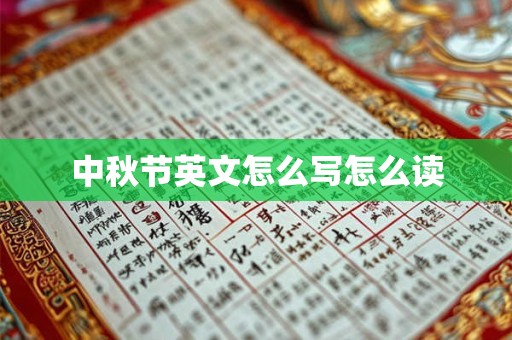The Mid-Autumn Festival, also known as the Moon Festival, is a traditional Chinese celebration that holds deep cultural significance. It's a time for families to gather, enjoy the full moon, and partake in various customs and activities. The name "Mid-Autumn Festival" in English is written as "Mid-Autumn Festival," and it is pronounced as "mɪd ˈɔːtəm ˈfɛstɪvəl."
The Origin of the Mid-Autumn Festival
The Mid-Autumn Festival has its roots in ancient China, with origins dating back to the Tang Dynasty (618-907 AD). It is believed to have originated from the moon worship of the ancient Chinese, who revered the moon as a symbol of harmony and completeness. The festival is also associated with the legend of Chang'e, the moon goddess, who is said to have ascended to the moon after consuming an elixir of immortality.
Celebrating the Full Moon
One of the most iconic aspects of the Mid-Autumn Festival is the appreciation of the full moon. It is believed that the moon is at its brightest and roundest during this time of the year. Families often gather to admire the moon together, often on the evening of the 15th day of the eighth lunar month.
Mooncakes: The Star of the Festival
Mooncakes are the centerpiece of the Mid-Autumn Festival. These round pastries symbolize reunion and completeness, as their shape resembles the full moon. They come in various flavors, including lotus seed, red bean, and egg yolk. Each family has its own recipe for mooncakes, and they are often given as gifts to friends and family.
The Legend of Chang'e
The story of Chang'e is a popular tale associated with the Mid-Autumn Festival. According to the legend, Chang'e was the wife of Hou Yi, a legendary archer who shot down nine suns to save the world from drought. As a reward for his bravery, the gods gave him an elixir of immortality. However, Hou Yi's jealousy of his wife's beauty led him to hide the elixir from her. When Chang'e discovered this, she consumed the entire elixir, causing her to float into the sky and become the moon goddess.
Moon Viewing Parties
Moon viewing parties are a common activity during the Mid-Autumn Festival. Families and friends gather in gardens, rooftops, or parks to enjoy the moonlight and each other's company. They may bring along tea, fruits, and mooncakes to share. The atmosphere is one of relaxation and celebration, as people reflect on the beauty of the moon and the importance of family and friendship.
Traditional Performances
Traditional performances, such as dragon and lion dances, are often part of the Mid-Autumn Festival celebrations. These performances are believed to bring good luck and fortune to the community. In some areas, there are also lantern shows, where beautifully crafted lanterns are displayed in the streets and parks.
Decorations and Lanterns
Decorations play a significant role in the Mid-Autumn Festival. Homes are adorned with lanterns, paper cuttings, and other festive items. The lanterns, in particular, are a symbol of light and hope. They come in various shapes and sizes, including representations of animals, flowers, and mythical creatures.
Mooncakes and Their Varieties
Mooncakes come in a variety of flavors and fillings, each with its own unique taste and cultural significance. Some popular flavors include:
- Lotus Seed: This is the most traditional flavor, with a sweet, nutty taste that complements the richness of the mooncake.
- Red Bean: A sweet and slightly salty flavor, red bean mooncakes are a favorite among many.
- Egg Yolk: These mooncakes are rich and savory, with a distinct egg yolk flavor that adds a luxurious touch.
- Pine Nut: Pine nut mooncakes have a crunchy texture and a rich, nutty flavor.
- Mango: A tropical twist on the traditional mooncake, mango mooncakes are sweet and juicy.
The Cultural Significance of the Mid-Autumn Festival

The Mid-Autumn Festival is not only a time for celebrating the full moon but also a time to honor family, friendship, and cultural heritage. It is a time for reflection and gratitude, as people come together to share in the joy of the season. The festival also serves as a reminder of the importance of unity and harmony, both within families and within the community.
Conclusion
The Mid-Autumn Festival is a time-honored tradition that brings people together to celebrate the beauty of the moon, the richness of their culture, and the bonds of family and friendship. Through its customs, foods, and stories, the Mid-Autumn Festival continues to be a cherished part of Chinese heritage, reminding us of the importance of unity and the joy of life.
